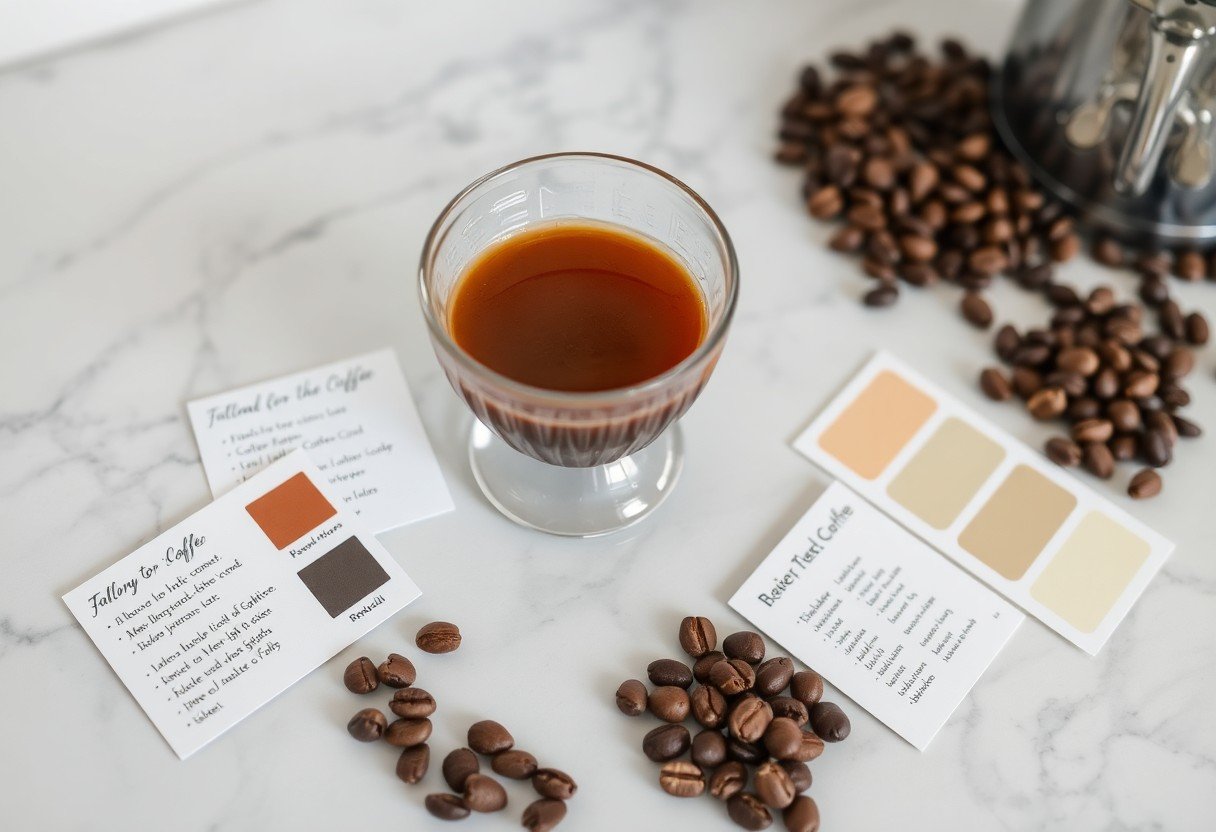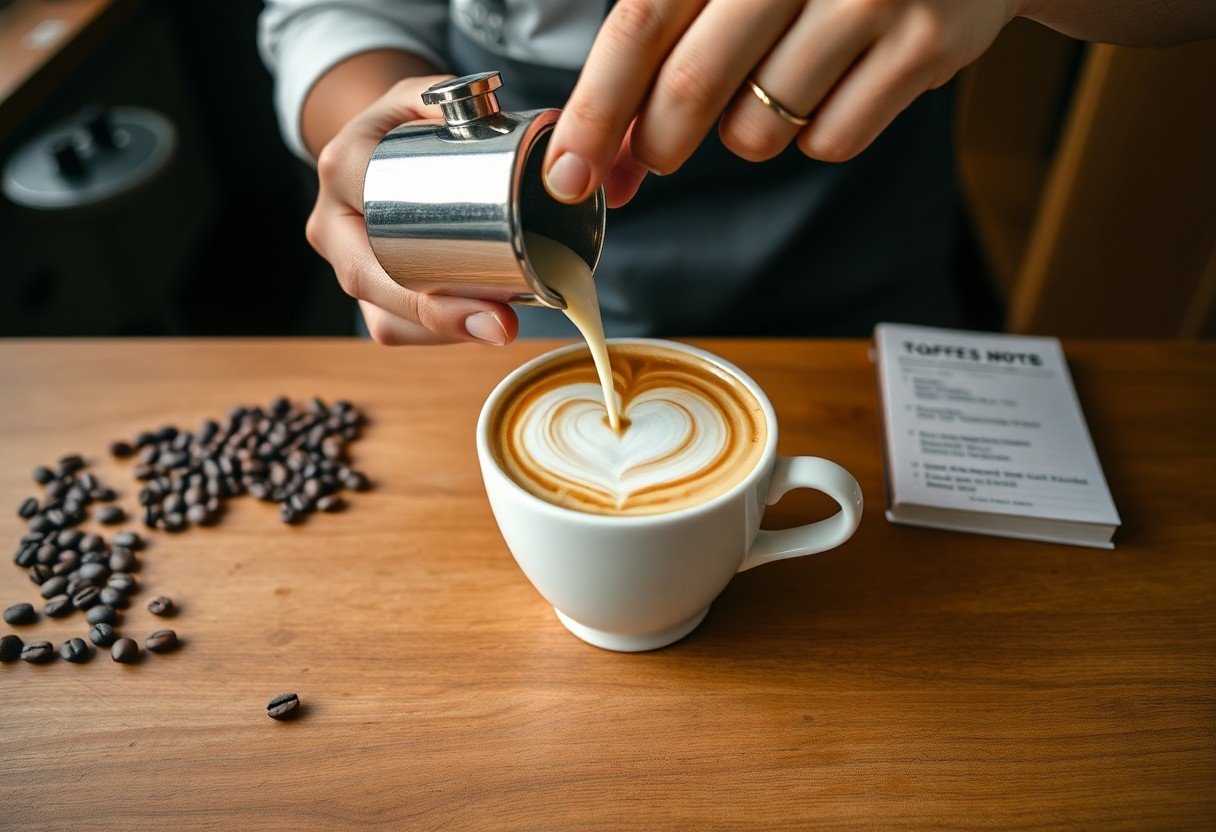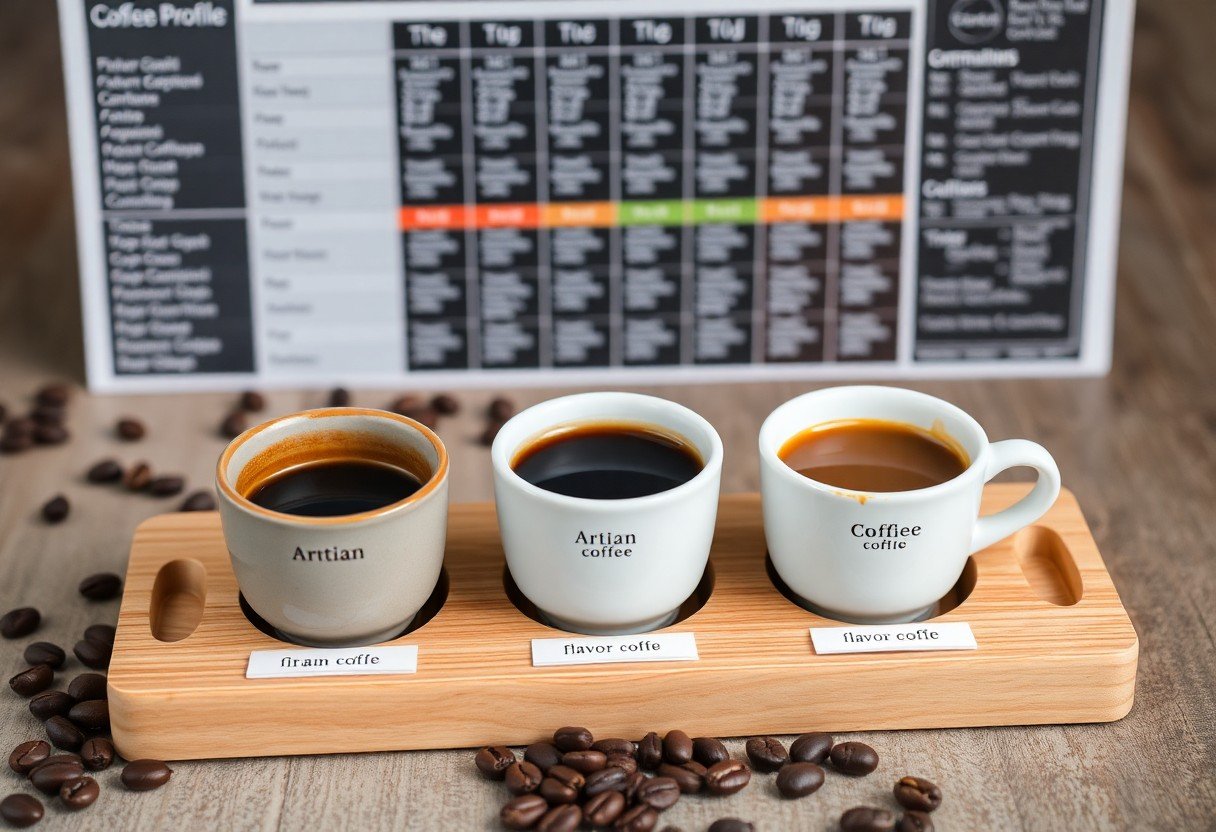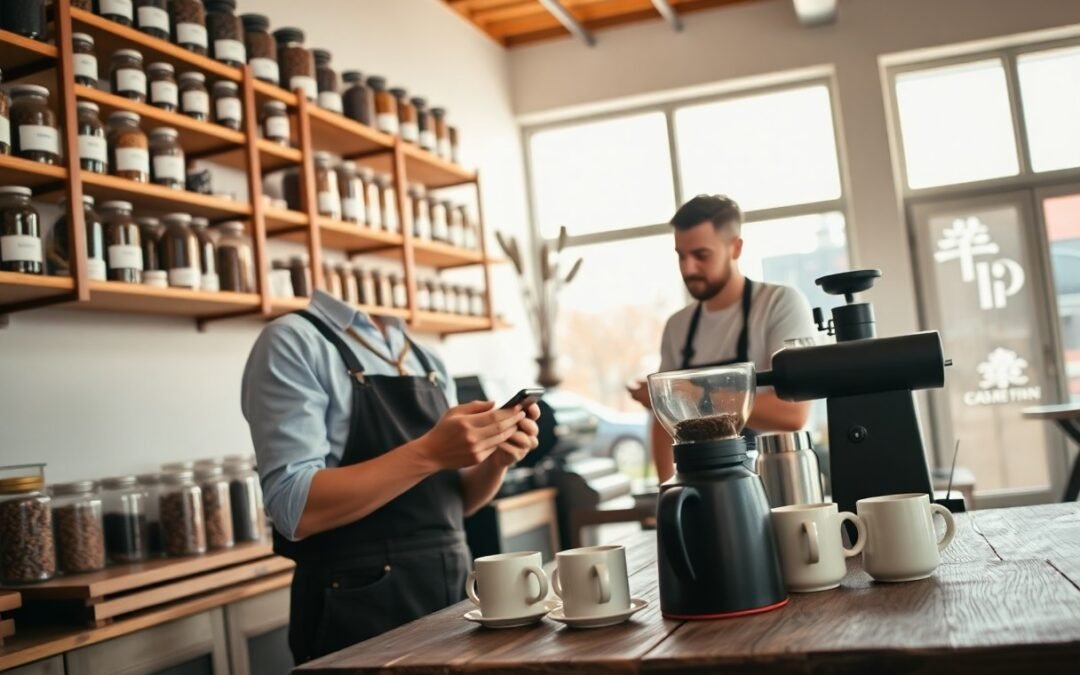You can unlock the secrets of rare artisan coffee flavor profiles by submerging into the world of specialty beans. With a little guidance, you will learn how to identify unique tastes and aromas that set these coffees apart. From understanding bean origins to perfecting your brewing techniques, this guide will equip you with the knowledge to savor each cup fully. Prepare to elevate your coffee experience and appreciate the intricate nuances that artisanal beans can offer.
Just examine the fascinating world of specialty coffee to uncover unique flavor profiles that set artisan beans apart. This guide will equip you with vital techniques and insights to identify and appreciate the rare and complex notes hidden within your coffee. By employing specific tasting methods and understanding the influence of origin and processing, you can enhance your coffee experience and discover flavors you never knew existed.
The Art of Sourcing Specialty Beans
Mastering the art of sourcing specialty beans requires keen insight into unique growing regions and the ability to identify high-quality coffee. Seek out producers who prioritize sustainability and objectivity in their practices, as this often results in more complex and delightful flavor profiles. Investigating the terroir—how soil, climate, and altitude impact taste—further enhances your selection process, allowing you to discover coffee that resonates with your personal palate.
Navigating the Coffee Supply Chain
Understanding the coffee supply chain is important for sourcing exceptional beans. From farm to cup, each step—harvesting, milling, and exporting—plays a key role in determining flavor quality. Engage with importers who specialize in niche markets, ensuring transparency and direct trade models that support farmers while providing you with the freshest selections possible.
Building Relationships with Artisan Roasters
Connecting with artisan roasters elevates your coffee experience. Regular interactions not only allow you to learn about their sourcing methods and roasting techniques, but also enable you to access exclusive, small-batch coffees. By attending cupping events or workshops hosted by these roasters, you gain firsthand knowledge while fostering a community around shared appreciation for quality coffee.
Building relationships with artisan roasters transforms your coffee journey. Regular communication helps you stay informed about their latest offerings, seasonal blends, and limited releases. Participating in direct purchasing or subscription programs can offer you unique beans unavailable elsewhere. Engaging with roasters on social media platforms or via newsletters also opens doors to tasting events, workshops, and insights into sourcing ethics, all of which deepen your understanding and enjoyment of artisan coffee.
Unveiling Flavor Nuances: The Art of Coffee Tasting
Engaging in coffee tasting unveils the diverse flavor profiles of specialty beans, guiding you through a journey of unique tastes and aromas. Each sip reveals intricate layers, from fruity notes to earthy undertones. Understanding these nuances is vital for appreciating the craftsmanship behind artisan coffee, allowing you to connect with a beverage that transcends its basic components. By honing your tasting skills, you not only elevate your coffee experience but also cultivate a deeper appreciation for the hard work of farmers and roasters alike.
Key Sensory Techniques for Flavor Identification
Employing sensory techniques enhances your ability to identify flavors in coffee. Begin by observing the aroma before tasting; inhale deeply and note what aspects stand out—fruity, floral, or nutty. When tasting, allow the coffee to coat your palate, paying attention to the acidity, sweetness, and body. Use a consistent scoring system to document your findings, enabling you to track differences between beans and refine your palate over time.
Building Your Flavor Vocabulary
Expanding your flavor vocabulary enriches your coffee-tasting experience. Familiarize yourself with common flavors found in specialty coffee, such as chocolate, caramel, citrus, or spice, by tasting diverse beans side by side. Engage with flavor wheels and tasting guides, which provide visual representations of potential notes. Utilizing descriptive language helps articulate your preferences, enhancing both personal enjoyment and communication with fellow coffee enthusiasts.
Understanding and building your flavor vocabulary allows for deeper connections between your preferences and the coffee you choose. By immersing yourself in the lexicon of coffee flavors, you can confidently express what you enjoy and seek out coffees that align with your taste. Consider attending cupping sessions or workshops, where interaction with experts will help you expand your palate and refine your descriptions. The practice of categorizing and naming flavors transforms your coffee journey from a simple habit into an informed exploration of the vast world of artisan brews.

The Flavor Spectrum: Exploring Tasting Notes
Diving into the flavor spectrum of specialty coffee unveils a complex array of tasting notes that vary from fruity and floral to nutty and chocolatey. By engaging your senses, you can begin to pinpoint these distinct characteristics, often influenced by roast levels and brewing techniques. Developing a vocabulary around these flavors enhances your appreciation and understanding of artisan beans, guiding you towards exceptional choices that cater to your palate.
Identifying Unique Flavor Profiles
Your ability to identify unique flavor profiles strengthens as you taste different brews. Consider using a flavor wheel that outlines various notes such as citrus, berry, or spices. Tasting several coffee types side by side can reveal subtle differences, allowing you to hone in on what flavors resonate with you. Explore note-rich experiences by documenting your findings; this not only enhances your tasting skills but also deepens your enjoyment of coffee.
The Role of Geographical Origin in Taste
The geographical origin of coffee beans plays a pivotal role in their flavor. Each region imparts distinct characteristics based on soil, elevation, and climate. For instance, Ethiopian coffees are often known for their wine-like and floral notes, while Colombian beans may provide a smoother, caramel-like profile. Understanding these regional nuances can enhance your selection process and elevate your coffee-drinking experience.
The Terroir Factor: Geography’s Impact on Coffee Flavor
Your coffee’s flavor is profoundly influenced by its terroir, the environmental conditions in which it is grown. Factors such as climate, altitude, and the uniqueness of the soil contribute to the complex flavor profiles of specialty beans. Understanding these elements can elevate your appreciation and enable you to identify distinct flavors associated with different regions around the world.
Understanding Coffee Growing Regions
Each coffee growing region—such as Ethiopia, Colombia, and Sumatra—boasts specific climatic conditions and cultural practices that significantly influence flavor. For instance, Ethiopian coffees often present vibrant floral and fruity notes, while Colombian beans are typically recognized for their balanced, chocolatey characteristics. Analyzing these regional traits can guide you in selecting beans that resonate with your taste preferences.
How Altitude and Soil Influence Taste
Altitude and soil composition play an vital role in defining coffee flavor. Beans grown at higher elevations tend to exhibit increased acidity and more complex flavors due to slower maturation. Additionally, volcanic soils rich in minerals can enhance sweetness and body. Exploring these variables helps in identifying unique flavor profiles that speak to the essence of specific growing regions.
For instance, coffee sourced from high-altitude regions of Guatemala often reveals a bright acidity and intricate flavor spectrum due to the cooler temperatures that slow down the ripening process. The mineral-rich volcanic soil supports nutrient absorption, resulting in beans that might present tasting notes of citrus and chocolate. Comparatively, lower elevation beans may yield a heavier body but lack the nuanced flavors found above certain altitudes. This geographical influence is vital in understanding what makes each coffee truly distinctive.

Brewing Techniques to Enhance Flavor Discovery
Utilizing the right brewing techniques can significantly elevate your experience with specialty coffee. Methods such as pour-over, French press, and aeropress each offer unique advantages for flavor extraction, allowing you to unlock intricate notes within your beans. Temperature, water quality, and brewing ratio all play pivotal roles in maximizing the complexity of your cup. Experimenting with these variables will reveal layers of flavor that characterize rare artisan coffees.
Methods for Optimal Extraction
Optimal extraction is achieved by balancing brewing time and temperature to enhance the coffee’s inherent characteristics. Aim for a water temperature between 195°F and 205°F, as this range allows necessary oils and flavors to dissolve effectively without over-extracting bitterness. Adjusting your brewing time based on the method used will also optimize flavors, with shorter times generally favoring brighter qualities and longer extractions deepening sweetness and body.
Experimenting with Grind Size and Brewing Time
Modifying grind size and brewing time can dramatically impact your coffee’s taste profile. A finer grind allows for quicker extraction, often bringing out brighter acidity and floral notes, while coarser grinds tend to produce bolder, richer flavors. An ideal brew time also depends on the method; for instance, pour-over techniques benefit from precise timing, typically ranging from two to four minutes, whereas cold brew requires up to 12 hours for optimal flavor development.
Understanding the interplay between grind size and brewing time lets you fine-tune your coffee experience. For example, if you find your brew lacking in depth, decreasing the grind size while slightly extending the brewing time can unlock richer flavors. Alternatively, if you desire a cleaner cup, coarser grounds and shorter durations might help achieve clarity in tasting notes. Keeping a detailed log of your adjustments can aid in consistently replicating your favorite outcomes.

Roast Profiles: The Science Behind Flavor Development
Your chosen roast profile significantly shapes the flavor characteristics of coffee beans. From light to dark, each roast level unlocks unique characteristics of the originating bean, influencing acidity, sweetness, and body. Lighter roasts tend to preserve more of the bean’s inherent flavors, while darker roasts often introduce deeper, bolder notes. The science behind this transformation lies in the complex chemical reactions that occur during roasting, directly affecting how you perceive flavor in your cup.
The Maillard Reaction and Its Role in Flavor
The Maillard reaction occurs during roasting, as sugars and amino acids react under heat, producing a variety of compounds that contribute to coffee’s flavor profile. This reaction initiates at around 300°F and continues as the roast develops, yielding sweet, nutty, and caramelized notes. It’s important to grasp the nuances of this reaction, as it helps determine whether your coffee expresses fruity brightness or rich, chocolaty undertones.
Recognizing Different Roast Levels
Differentiating between roast levels can enhance your coffee selection process. Light roasts embrace bright, acidic flavors with floral and fruity notes, generally retaining more caffeine. Medium roasts offer a balance of acidity and body, showcasing both the bean’s origin and the roaster’s influence. Dark roasts, with their deep, bold characteristics, often exhibit smoky, bitter flavors, masking some of the bean’s original attributes. Understanding these distinctions helps you identify the roast that aligns with your flavor preferences.
Visual cues like color and surface texture can aid in recognizing roast levels. Light roasts present a tan color with a matte finish, while medium roasts exhibit a medium brown hue with potential slight oiliness. Dark roasts are typically dark brown to almost black, often appearing slick due to the oils released during roasting. Tasting notes commonly reflect these visual characteristics—lighter roasts may remind you of citrus or berries, whereas darker roasts could evoke caramel, chocolate, or earthy flavors. Engaging with a variety of roast levels allows you to cultivate a deeper appreciation for the complex spectrum of flavors available in artisan coffees.
Building a Coffee Tasting Journal
Creating a coffee tasting journal is a powerful way to track and articulate your flavor experiences. By systematically noting your impressions of each coffee, you cultivate a deeper understanding of taste profiles and personal preferences. Document details such as origin, roast level, aroma, flavor notes, body, acidity, and your brewing method alongside your ratings. This practice transforms your casual coffee sessions into a rich sensory exploration, allowing you to revisit and compare tasting notes over time.
Documenting Your Flavor Journey
As you explore various coffees, documenting your flavor journey helps you connect specific beans to your personal taste discoveries. Use descriptive language to capture your sensory experiences and emerging preferences. By identifying recurring notes or textures that resonate with you, your journal becomes a personalized roadmap for future coffee selections, guiding you toward delicious discoveries.
Analyzing Your Preferences Over Time
Over time, reviewing your coffee tasting journal reveals patterns in your flavor preferences. You may notice a consistent attraction to certain regions, roast levels, or tasting notes. This analysis enables you to refine your coffee choices, steering you toward beans that align with your evolving palate. Understanding these trends can elevate your tasting experience, helping you curate selections that you are more likely to enjoy.
Analyzing your preferences offers insight into your evolving taste landscape. You might find, for example, that lighter roasts with floral notes consistently excite your palate, while darker roasts fail to impress. Recognizing these trends allows for intentional selections when exploring new beans. Consider keeping a separate section in your journal dedicated to these insights, where you can highlight favorite coffees and inform conversations with baristas or roasters, enriching your coffee exploration journey further.
Crafting Your Own Flavor Experience: Brewing Techniques
Employing various brewing techniques allows you to bring out the unique flavors hidden within specialty coffee beans. Experimenting with methods such as pour-over, French press, or AeroPress can dramatically alter the sensory profile of your coffee. Each technique emphasizes different solubility and extraction properties, helping you to discover the rich tapestry of taste notes that artisan beans can offer.
Brewing Methods That Enhance Nuances
Selecting the right brewing method can elevate specific flavor characteristics. Pour-over methods highlight clarity and brightness, while immersion techniques like French press enhance body and richness. Consider employing a vacuum brewer for an intricate flavor profile, or a siphon brewer for a theatrical experience as well as complex notes, providing a unique opportunity to explore variations in taste and aroma from your artisan beans.
Temperature and Extraction Time: A Delicate Balance
The right temperature and time can make or break your coffee experience. Most brewing methods flourish at temperatures between 195°F and 205°F (90-96°C). Keeping extraction times between 2 to 4 minutes optimizes flavor compounds without introducing undesirable bitterness, allowing you to savor the nuanced characteristics of your chosen beans.
Temperature and Extraction Time: A Delicate Balance
| Factor | Recommendation |
|---|---|
| Optimal Brewing Temperature | 195°F to 205°F (90-96°C) |
| Ideal Extraction Time | 2 to 4 minutes |
Carefully controlling the brewing temperature and extraction time directly influences the flavor profile. For instance, brewing at lower temperatures may preserve delicate fruity notes, while hotter water can bring out robust, earthy flavors. Adjusting extraction times further tailors your experience; a longer steep may yield more body, while a shorter duration enhances brightness. Testing and tweaking these variables will help you discover the perfect balance tailored to your personal taste preferences.
Temperature and Extraction Time: A Delicate Balance
| Influence | Result |
|---|---|
| Higher Temperature | Increased bitterness, reduced sweetness |
| Lower Temperature | More acidity, enhanced fruity notes |
| Short Extraction Time | Bright, acidic profile |
| Long Extraction Time | Full-bodied and rich |

Engaging with the Coffee Community
Immersing yourself in the coffee community enhances your knowledge and appreciation of specialty beans. Engaging with fellow enthusiasts allows you to share insights and discover unique flavor profiles that you may not have encountered on your own. Building relationships with baristas, roasters, and other coffee aficionados can provide invaluable perspectives and recommendations tailored to your palate.
Participating in Tastings and Events
Joining tastings and events showcases a hands-on approach to exploring coffee. Local cafés and roasteries frequently host cupping sessions, where you can sample various beans side-by-side, honing your ability to discern subtle flavor notes. Attending workshops led by industry experts often reveals the art and science behind different brewing methods, enhancing your skill set and appreciation for high-quality coffee.
Connecting with Online Forums and Groups
Online forums and groups offer a wealth of information and community support. Whether you join specialized platforms like Home-Barista or Reddit’s r/Coffee, you gain access to resources that cover everything from brewing techniques to bean sourcing. Engaging in discussions, asking questions, and sharing experiences with a global network of coffee lovers help you refine your palate and stay updated on emerging trends in the artisan coffee world.
Connecting with online communities can significantly broaden your coffee knowledge. These platforms often feature detailed threads discussing specific origins, flavor profiles, and techniques that can help you pinpoint what excites your taste buds. Participating in these forums also allows you to seek recommendations for local sourcing, discover new roasting styles, and connect with others who share your passion, creating a collaborative atmosphere that fosters learning and discovery.
Beyond the Bean: The Role of Storage and Freshness
Storage and freshness significantly influence the flavor profiles of specialty coffee. Beans are highly sensitive to their environment, and preserving their intrinsic qualities is vital for a great tasting experience. Proper storage techniques, including airtight containers and cool, dark locations, help maintain freshness, while improper handling can lead to a loss of flavor and aroma. You must ensure your beans are not exposed to light, air, or moisture, as these elements can negatively impact their delightful nuances.
How Storage Conditions Affect Flavor Profiles
The environment in which your coffee beans are stored directly affects their flavor. Temperature fluctuations and exposure to air can lead to oxidation, diminishing the vibrant notes you seek. For instance, storing beans in a pantry near heat sources or in clear containers can result in a stale, flat taste. Aim for consistent temperatures and consider using vacuum-sealed bags to extend the life of your precious beans.
Identifying Freshness in Specialty Beans
Freshness can be identified through several key indicators. First, check the roast date on the packaging; coffee is typically best within two to three weeks post-roasting. Additionally, inspect the aroma; fresh beans should emit a lively scent, while stale beans may have little to no fragrance. Finally, look for oily surfaces; while some oils are natural, excessive oiliness often indicates older beans.
To investigate deeper into identifying freshness, keep in mind the visual cues and tactile elements. Freshly roasted beans are often glossy but should also have a matte appearance if you choose lighter roasts. You can also perform a simple freshness test by giving the beans a gentle squeeze in a bag; a fresh batch will release gas due to CO2, while older beans will feel flat and unresponsive. By honing in on these details, you can truly appreciate the distinct flavors hidden within specialty beans.
Conclusion
On the whole, discovering rare artisan coffee flavor profiles in specialty beans requires you to explore diverse sources, engage with knowledgeable roasters, and experiment with brewing techniques. By honing your palate and learning the language of flavors, you can unlock a world of unique and complex tastes that elevate your coffee experience. Embrace each cup as an opportunity to deepen your understanding and appreciation of artisan coffee, ensuring a rewarding journey through its rich and varied landscape.
Summing up
On the whole, discovering rare artisan coffee flavor profiles in specialty beans requires you to explore various sourcing methods, brewing techniques, and tasting notes. Familiarize yourself with different origins and processing methods, attend tastings, and engage with knowledgeable baristas. By paying attention to your preferences and experimenting with brewing styles, you can uncover the unique nuances and complexities that specialty coffees offer, ultimately elevating your coffee experience.
FAQ
Q: What factors influence the flavor profiles of rare artisan coffee beans?
A: Factors include origin, altitude, processing method, and the variety of the coffee plant. Each factor contributes unique characteristics to the coffee’s flavor, aroma, and acidity.
Q: How can I identify the flavor notes in a cup of coffee?
A: Tasting involves using your senses: observe the aroma, taste small sips, and consider the aftertaste. Using a flavor wheel can help pinpoint specific notes like fruity, floral, or nutty flavors.
Q: What is the importance of brewing methods in discovering flavor profiles?
A: Different brewing methods, such as pour-over, French press, or espresso, can extract distinct flavors from coffee. Experimenting with various techniques can reveal the complexity of artisan beans.
Q: How can I enhance my tasting experience for rare artisan coffees?
A: To enhance your experience, use pure water, maintain optimal brewing temperatures, and minimize distractions. Tasting with friends or in guided cuppings can also enrich the experience.
Q: Where can I find specialty beans that offer unique flavor profiles?
A: Specialty coffee roasters, local coffee shops, and online marketplaces often carry rare artisan beans. Look for roasteries that emphasize single-origin products for unique flavor experiences.

